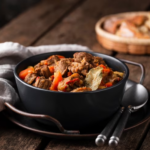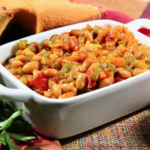When it comes to East African cuisine, few dishes embody simplicity and satisfaction like Ugali and Sukuma Wiki. This classic combination of cornmeal porridge and collard greens has been a staple in the diets of many East Africans for generations. With its humble ingredients and comforting flavors, Ugali and Sukuma Wiki offer a glimpse into the culinary traditions and everyday nourishment of the region. Let’s explore the delights of these dishes and discover why they hold a special place in East African hearts.
Ugali: The Heart of East African Cuisine
Ugali, also known as sima, sembe, or nsima depending on the region, is a staple food in East Africa, particularly in countries such as Kenya, Tanzania, and Uganda. Made from finely ground cornmeal or maize flour and water, Ugali is a simple yet versatile dish that serves as a foundation for many meals.
The preparation of Ugali involves mixing cornmeal with boiling water and continuously stirring until it reaches a thick, smooth consistency. It is then left to cook further, allowing the cornmeal to fully hydrate and solidify. The resulting Ugali has a smooth texture and can be molded into a firm, dough-like ball.
Sukuma Wiki: The Everyday Greens
Sukuma Wiki, which translates to “push/stretch the week” in Swahili, refers to collard greens or kale that are commonly cooked and enjoyed as a side dish with Ugali. The name reflects its affordability and availability, making it a go-to vegetable for stretching meals throughout the week.
Sukuma Wiki is typically prepared by sautéing the greens with onions, tomatoes, and various seasonings. The combination of flavors and textures creates a delicious and nutritious accompaniment to the Ugali, adding a vibrant burst of green freshness to the meal.
The Perfect Pairing
Ugali and Sukuma Wiki complement each other perfectly, both in terms of taste and nutritional value. Ugali provides a satisfying, neutral base that absorbs the flavors of other dishes, while Sukuma Wiki adds a burst of freshness and essential nutrients to the meal.
To enjoy this delightful combination, a small portion of Ugali is taken, rolled into a ball or flattened on the plate, and then used to scoop up bites of Sukuma Wiki. The act of tearing off a piece of Ugali and using it as a utensil to pick up the greens is a common practice in East African dining, adding a communal and interactive element to the meal.
Cultural Significance and Beyond
Ugali and Sukuma Wiki have deep cultural significance in East African communities. They represent the resilience, resourcefulness, and simplicity of the region’s cuisine. These dishes are not only enjoyed at home but can also be found in local restaurants and street food stalls, showcasing their popularity and widespread appeal.
Beyond their cultural significance, Ugali and Sukuma Wiki are celebrated for their nutritional value. Ugali is a rich source of carbohydrates, while Sukuma Wiki is packed with vitamins, minerals, and dietary fiber. Together, they provide a balanced and nourishing meal that fuels both the body and the soul.
Ugali and Sukuma Wiki are the epitome of simple and satisfying East African cuisine. Their humble ingredients, straightforward preparation, and harmonious flavors exemplify the beauty of everyday meals that bring comfort, nourishment, and a sense of community. Whether enjoyed in a cozy home or a bustling eatery, Ugali and Sukuma Wiki continue to hold a special place in the hearts of East Africans, reminding them of their cultural heritage and the joy of uncomplicated yet delicious meals.








